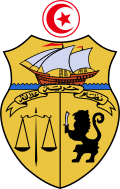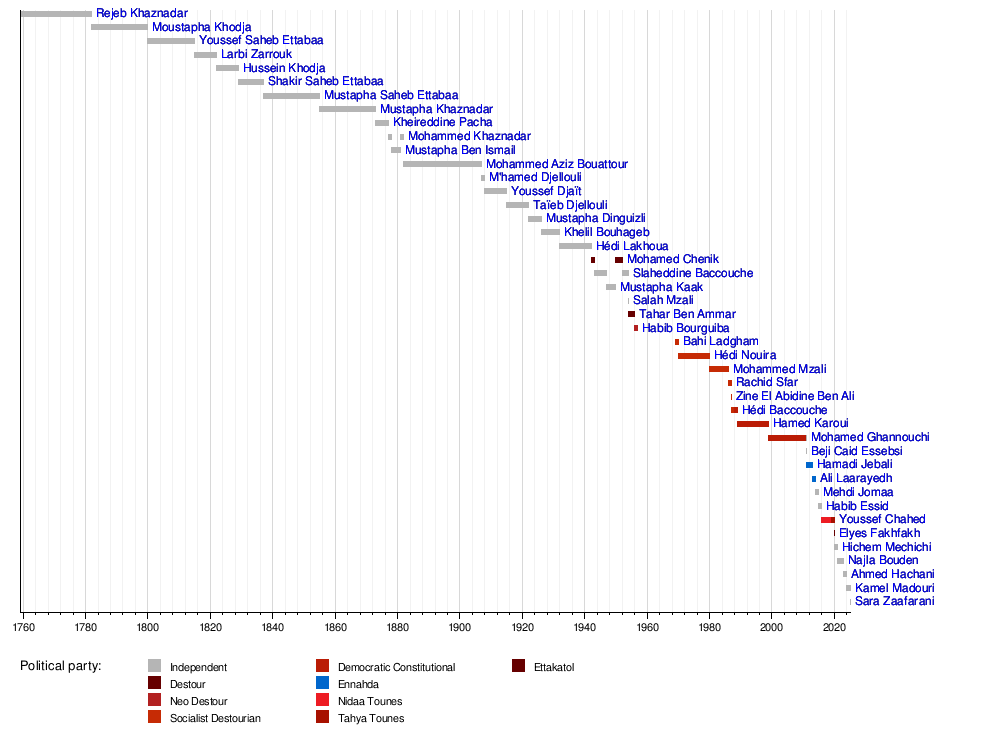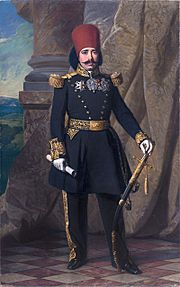Prime Minister of Tunisia facts for kids
Quick facts for kids Prime Minister of the Republic of Tunisia |
|
|---|---|

Coat of arms of Tunisia
|
|
| Cabinet of Tunisia | |
| Style | Prime Minister (informal) His/Her Excellency (formal, diplomatic) |
| Member of | Cabinet |
| Reports to | |
| Residence | Dar El Bey |
| Appointer | President of Tunisia |
| Term length | Variable |
| Constituting instrument | Constitution of Tunisia |
| Formation | 12 February 1759 |
| First holder | Rejeb Khaznadar |
| Salary | 8000TND monthly (US$ 2,867) |
The Prime Minister of Tunisia (Arabic: رئيس حكومة تونس, romanized: re’īs ḥukūmet Tūnis) is the main leader of the executive branch of the government of Tunisia. Think of them as the head of the team that runs the country day-to-day. The Prime Minister works closely with the President. Together with their cabinet (a group of ministers), they are responsible for the government's actions and policies. They answer to the Assembly of the Representatives of the People (Tunisia's parliament), their political party, and ultimately, to the people who voted for them.
The role of Prime Minister was first created in 1759 by Monarch Ali II. Rejeb Khaznadar was the very first person to hold this important job. The position was brought back in 1969 by Habib Bourguiba, with Bahi Ladgham becoming Prime Minister.
For a while, the President had most of the power. But after the Tunisian Revolution in 2011, the Prime Minister gained more responsibilities and shared executive power with the President. However, a new constitution in 2022 gave the President much more power, making Tunisia a presidential republic and limiting the parliament's role.
The President chooses the Prime Minister. This person is usually from the political party that won the most seats in the parliamentary election. The chosen Prime Minister then has one month to form a cabinet (their team of ministers). This team must be approved by the parliament. If approved, they are officially sworn in by the President. The parliament can also remove the Prime Minister and their cabinet through a special vote if they lose confidence in them.
Since 1759, 47 different people have served as Prime Minister. The current Prime Minister is Sara Zaafarani, who started her role on March 21, 2025.
Contents
History of the Prime Minister Role
During the time when Tunisia was a monarchy, the Prime Minister was the head of the government. They managed the country's affairs and were chosen or removed by the Bey (the ruler). This role began in 1759 under Ali II, with Rejeb Khaznadar as the first Prime Minister.
For a long time, this job was held by people called Mamluks. These were people of foreign origin who came to Tunisia when they were young. They served the Royal Family and the government. Famous examples include Mustapha Khaznadar and Kheireddine Pacha.
Mohammed Aziz Bouattour was the first Tunisian-born person to become Prime Minister in 1882. He held the position for almost 25 years, which is the longest in Tunisia's history. During his time, the French protectorate (when France controlled Tunisia) was established.
Before Tunisia gained its independence, Prime Ministers were not usually part of a political party because they were chosen by the monarch. There were no parliamentary elections until 1956. After independence, Habib Bourguiba became the first Prime Minister chosen through an election in 1956.
There were a couple of exceptions, like Mohamed Chenik (in 1943 and 1950) and Tahar Ben Ammar (in 1954). They were part of the Destour Party and were appointed by the Bey. This caused some problems, especially in 1943, because the Bey did not discuss the appointment with the French Resident General. This led to a political crisis and the Bey's removal.
The role of Prime Minister was stopped after the parliament ended the monarchy and created a republic. Prime Minister Bourguiba then became the first President of the Republic of Tunisia. The Prime Minister's office was empty until 1969. It was brought back when the government system changed to a semi-presidential one.
How the Prime Minister is Chosen
After a national election, the President picks a candidate. This person is usually from the party that won the most votes. They then have one month to form a government. The chosen Prime Minister must present their plans to the Assembly of the Representatives of the People (parliament). They need to get the support of most of the members before the President officially appoints them.
If the candidate cannot form a government or does not get enough support, the President talks to other political parties to find a new candidate. If, after four months, the parliament still has not approved a Prime Minister, the President can call for a new election.
When appointed, the Prime Minister takes an oath in front of the President. This oath is:
I swear by Almighty God to work faithfully for the good of Tunisia, to respect its Constitution and laws, scrupulously to their interests and serve loyally.
What the Prime Minister Does
The powers of the Prime Minister are set out in Tunisia's current Constitution of Tunisia from 2014. The Prime Minister is mainly in charge of things happening inside the country. The President handles foreign policy, defense, and national security.
The Prime Minister is responsible for:
- Creating, changing, or closing government ministries (except for the Ministries of Defense and Foreign Affairs, which need the President's approval).
- Creating, changing, or closing public organizations and government departments.
- Issuing government rules after talking with the Council of Ministers (the cabinet).
- Approving and signing official orders made by other ministers.
- Asking the parliament to vote on whether they still trust the government.
The Prime Minister and the President together represent Tunisia both at home and around the world.
If the President cannot do their job for a short time, the Prime Minister can act as President for up to 60 days. If the President's inability is permanent (due to resignation or death), the Speaker of the Parliament becomes the temporary President. This temporary role lasts for 45 to 90 days until new elections can be held.
Timeline of Prime Ministers

See also
 In Spanish: Jefe de Gobierno de Túnez para niños
In Spanish: Jefe de Gobierno de Túnez para niños
- Tunisia
- List of prime ministers of Tunisia
- President of Tunisia


